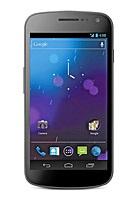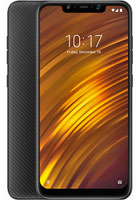Samsung Galaxy Nexus (GT-i9250M) vs Xiaomi Pocophone F1 (Armoured edition)
Side by side comparison between Samsung Galaxy Nexus vs Xiaomi Pocophone F1 phones, differences, pros, cons and full specifications. What's the better?
,
4.65"
AMOLED
AMOLED
720x1280
5
MP
MP
1.3mp
1GB
RAM
RAM
Dual-core
1750
mAh
mAh
(Removable)
vs
6.18"
IPS
IPS
1080x2246
12
MP
MP
20mp
8GB
RAM
RAM
Octa-core
4000
mAh
mAh
(Non removable)
What's the better phone? Xiaomi Pocophone F1 (Armoured edition)
The phonemore's choice is much more technical than personal. Therefore, you shouldn't only consider this. Our goal is to help you, but what's important to us may not be important to you. You decide which one is the best! Comment!
| 22 Common items in both devices |
| Plastic body, glass front |
| 60Hz |
| 16 million |
| Only digital zoom |
| Autofocus / PDAF: phase detection autofocus |
| Capacitive |
| Multitouch |
| +15 specs and more in the table below |
Check the comparison table below for more items that are not evaluated in comparison score above.
Highlight differences Clear highlight📱 Model features | ||
| Galaxy Nexus (GT-i9250M) | Xiaomi Pocophone F1 (Armoured edition) | |
| Model | Galaxy Nexus (GT-i9250M) | Pocophone F1 (Armoured edition) |
| Other model names | Telus/Bell Google Galaxy Nexus 3G, Samsung Yakju | Xiaomi Pocophone F1 Armored edition with Kevlar (256GB+8GB) |
| Country or region available |  Canada |  (Global, International) |
| Brand | Samsung | Xiaomi |
| Release date | 1/16/2012, Announced: 10/29/2011 | 8/29/2018 |
| Depth | 8.94 millimeters (0.35 inches) | 8.9 millimeters (0.35 inches) |
| Size (width x height) | 67.94 x 135.5 millimeters (2.67 x 5.33 in) | 75.5 x 155.7 millimeters (2.97 x 6.13 in) |
| Weight | 135 grams (4.73 ounces) | 187 grams (6.55 ounces) |
| Build, materials | Plastic body, glass front | Plastic body, glass front |
| Protection against water and others | Not supported | Not supported |
📲 Display | ||
| Galaxy Nexus (GT-i9250M) | Xiaomi Pocophone F1 (Armoured edition) | |
| Display type | Super AMOLED | TFT IPS LCD |
| Screen size | 4.65" inches | 6.18" inches |
| Screen-to-body ratio | ~64.8% (screen-to-body ratio) | ~81.9% (screen-to-body ratio) |
| Display resolution | 720x1280 pixels (16:9) | 1080x2246 pixels (18.7:9) |
| Touchscreen | Capacitive Multitouch | Capacitive Multitouch 10-points |
| Pixel density (dot pitch) | 316 PPI | 403 PPI |
| Colors | 16 million | 16 million |
| Scratch-resistant glass | Not supported | Gorilla Glass 3 |
| Refresh rate | 60Hz | 60Hz |
| Display features | Not supported | Not supported |
🤖 Operating System | ||
| Galaxy Nexus (GT-i9250M) | Xiaomi Pocophone F1 (Armoured edition) | |
| System version | Android 4.0.3 Ice Cream Sandwich ICS | Android 8.1 Oreo |
| Firmware update | Android 4.1.1 Jelly Bean | Android 10 |
| User Interface | feature not registered | MIUI 9 / 10 / 12 |
⚙️ Processor | ||
| Galaxy Nexus (GT-i9250M) | Xiaomi Pocophone F1 (Armoured edition) | |
| Chipset | 32bit: Texas Instruments OMAP 4460 (45nm) | 64bit: Qualcomm Snapdragon 845 (SDM845) (10nm) |
| CPU | Dual-core, 1 processor: 2x 1.2GHz ARM Cortex-A9 (Dual-core) | Octa-core, 2 processors: 4x 2.8GHz Kryo 385 Gold (Quad-core) 4x 1.7GHz Kryo 385 Silver (Quad-core) |
| GPU graphical controller | PowerVR SGX540 MP1 (384MHz) | Qualcomm Adreno 630 (710MHz) |
| Performance (benchmark) | AnTuTu: 7241 (v3) | feature not registered |
💽 Memory and storage | ||
| Galaxy Nexus (GT-i9250M) | Xiaomi Pocophone F1 (Armoured edition) | |
| RAM memory | 1GB LPDDR2 | 8GB LPDDR4X |
| Internal storage | 16GB (13GB available) | 256GB (240GB available) UFS 2.1 |
| External storage | Not supported | Until 256GB microSD, microSDXC (hybrid slot/shares the same SIM-2 slot) |
📶 Mobile networks | ||
| Galaxy Nexus (GT-i9250M) | Xiaomi Pocophone F1 (Armoured edition) | |
| Dual-SIM | Not supported | Dual-SIM Standby - Call active on one sim card (hybrid slot/shares the same microSD slot) |
| SIM card | 1 slot (Single-SIM) Standard mini-SIM (2FF) | 2 slots (Dual-SIM) nano-SIM (4FF) |
| Maximum Download / Upload | 21/5.76 Mbps | 1024/150 Mbps |
| Network technology | 2G, 3G | 2G, 3G, 4G |
| Frequency, bands | Expand band details Collapse details | |
| GSM MHz band | Quad-Band 850/900/1800/1900 | Quad-Band 850/900/1800/1900 |
| Primary 2G network | GSM 850/900/1800/1900 | GSM 850/900/1800/1900 |
| Primary 3G network | UMTS 850/1700/1900/2100 | UMTS 850/900/1900/2100 |
| Primary 4G network | Not supported | LTE Cat16 (1, 3, 5, 7, 8, 20) TD-LTE (38, 40, 41) |
| Primary 5G network | Not supported | Not supported |
| Primary data network | GPRS, EDGE, UMTS, HSDPA, HSUPA, HSPA+ | GPRS, EDGE, UMTS, HSDPA, HSUPA, HSPA+, TD-LTE, LTE, LTE-A |
| Secondary 2G network | Not supported | GSM 850/900/1800/1900 |
| Secondary 3G network | Not supported | Not supported |
| Secondary 4G network | Not supported | Not supported |
| Secondary data network | Not supported | GPRS, EDGE |
📷 Camera | ||
| Galaxy Nexus (GT-i9250M) | Xiaomi Pocophone F1 (Armoured edition) | |
| Back camera (main camera) | 5 megapixels | (dual camera) 12 megapixels 5MP depth f/2.01.12µm |
| Main camera resolution | 2592x1944 pixels | 4000x3000 pixels |
| Video recording (primary) | Full HD (1920x1080) 30 fps | 4K UHD (3840x2160) 30 fps |
| Flash | LED flash | Dual-LED flash |
| Focal aperture | f/2.8 (aperture) | f/1.9 (aperture) |
| Focal length | feature not registered | feature not registered |
| Sensor size | feature not registered | 1/2.55" inches |
| Pixel size | feature not registered | 1.4µm pixel |
| Autofocus | Autofocus | PDAF: phase detection autofocus |
| Touch focus | Supported | Supported |
| Image stabilization | Not supported | EIS: Digital stabilization |
| Zoom | Only digital zoom | Only digital zoom |
| Face/smile detection | Face detection | Face detection, Smile detection |
| BSI sensor | Not supported | Not supported |
| HDR | Not supported | HDR photo on both cameras |
| Camera extras | feature not registered | feature not registered |
📸 Front camera | ||
| Galaxy Nexus (GT-i9250M) | Xiaomi Pocophone F1 (Armoured edition) | |
| Front camera (secondary) | 1.3 megapixels | 20 megapixels |
| Front camera resolution | 1280x1024 pixels | 5184x3840 pixels |
| Video recording (secondary) | HD (1280x720) | Full HD (1920x1080) |
| Front flash | Not supported | Not supported |
| Focal aperture | feature not registered | f/2.0 (aperture) |
| Focal length | feature not registered | feature not registered |
| Sensor size | feature not registered | feature not registered |
| Pixel size | feature not registered | 0.9µm pixel |
🔉 Sound and multimedia | ||
| Galaxy Nexus (GT-i9250M) | Xiaomi Pocophone F1 (Armoured edition) | |
| Loudspeaker | Supported | Stereo sound |
| Active noise cancellation | 2 microphones or more | 2 microphones |
| Radio | Not supported | FM |
| TV | Not supported | Not supported |
| Video formats | MP4, H.264, H.263 | MP4, H.265, H.264, H.263, DivX, XviD |
| Audio formats | MP3, WAV, eAAC+, AC3 | MP3, OGG, eAAC+, FLAC |
🔌 Connectivity | ||
| Galaxy Nexus (GT-i9250M) | Xiaomi Pocophone F1 (Armoured edition) | |
| USB | MicroUSB 2.0 | USB 2.0 Type-C, USB OTG On-The-Go |
| Audio output | 3.5mm jack | 3.5mm jack |
| TV output | Micro-B USB MHL | Not supported |
| Bluetooth | 3.0 + A2DP | 5.0 + A2DP/LE |
| WiFi | 802.11 a/b/g/n [wifi4] (2.4GHz, 5GHz) | 802.11 a/b/g/n/ac [wifi5] (2.4GHz, 5GHz) + MIMO WiFi Direct, WiFi Display, hotspot |
| DLNA | Supported | Supported |
| GPS | A-GPS, GeoTagging | A-GPS, GeoTagging, GLONASS, BeiDou |
| NFC | Supported | Not supported |
| Infrared port | Not supported | Not supported |
🧭 Sensors | ||
| Galaxy Nexus (GT-i9250M) | Xiaomi Pocophone F1 (Armoured edition) | |
| Sensors | Accelerometer Ambient light sensor Barometer Compass Gyroscope Proximity sensor | Accelerometer Ambient light sensor Barometer Compass Face unlock 2D Fingerprint sensor (rear-mounted) Gyroscope Hall effect Proximity sensor |
| Vibrating alert | Supported | Supported |
🔋 Battery | ||
| Galaxy Nexus (GT-i9250M) | Xiaomi Pocophone F1 (Armoured edition) | |
| Battery type | Li-Ion: lithium-ion (Removable) | LiPo: li-ion polymer (Non removable) |
| Battery capacity | 1750 mAh | 4000 mAh |
| Charger, watts | Wired charging | 18W (9V/2A) Wired fast charging Quick Charge 3 |
| Inductive / wireless charging | Not supported | Not supported |
| Talk time autonomy | 8.3 hours | feature not registered |
| Standby | 270 hours (11.3 days) | feature not registered |
➕ Other features | ||
| Galaxy Nexus (GT-i9250M) | Xiaomi Pocophone F1 (Armoured edition) | |
| Call control | Voice dialing, Voice recorder, Voice commands | Voice dialing, Voice recorder |
| Messaging | SMS (T9), MMS, E-mail, Push mail | SMS (T9), MMS, E-mail, Push mail |
| Hands-free calling | Supported | Supported |
| Video calling | Supported | Supported |
| Ringtones | Polyphonic and customized | Polyphonic and customized |
| Web browser | HTML, XHTML, HTML5, Flash player | HTML, XHTML, HTML5 |
| Antenna | Internal antenna | Internal antenna |
| Qwerty physical keyboard | Not supported | Not supported |
| Miscellaneous | • Colors: Black • Curved glass screen (Contour Display) • Oleophobic coating resistance screen • Google Maps 5.0 3D • WiFi hotspot • Java framework | • Colors: Black armored with Kevlar • LiquidCool technology |
☢️ Radiation rate | ||
| Galaxy Nexus (GT-i9250M) | Xiaomi Pocophone F1 (Armoured edition) | |
| SAR 1.6W/kg (USA, Mexico, etc.) | 0.4W/kg (head), 0.74W/kg (body) | feature not registered |
| SAR 2W/kg (Europe, UK, etc.) | 0.354W/kg (head) | feature not registered |


 4 Advantages
4 Advantages  28 Advantages
28 Advantages